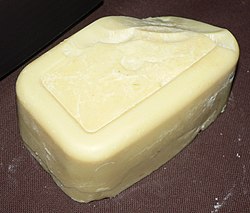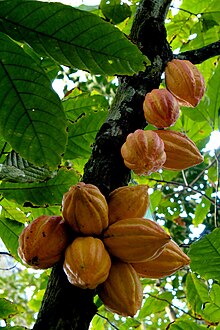Cocoa butter
| Cocoa butter | |
|---|---|

|
|
| Raw material plant (noun) |
Cocoa tree ( Theobroma cacao ) |
| origin |
Seeds |
| colour |
pale to light yellow |
| ingredients | |
| Oleic acid | 32-37% |
| Linoleic acid | 2-4% |
| Palmitic acid | 22-30% |
| More fatty acids | Stearic acid 30-37%, arachidic acid 1.2%, palmitoleic acid 0.5%, gamma-linolenic acid 0.2%, behenic acid 0.2% |
| properties | |
| density | 0.945-0.976 at 15 ° C |
| viscosity | = 42 mPas at 40 ° C |
| Oxidation stability | 32-38 h |
| Melting point | 28-36 ° C |
| Iodine number | 32-40 |
| Saponification number | 190-200 |
| Manufacturing and Consumption | |
| Most important production countries | Ghana , Indonesia , Brazil , Ivory Coast , Cameroon , Nigeria |
| use | Food, cosmetics, industry |
Cocoa butter , also called cocoa fat , in Latin oleum cacao , is a pale yellow, aromatic fat that is obtained from the seeds of the cocoa tree .
Extraction
Cocoa butter is the filtered or centrifuged fat obtained by pressing from cocoa kernels or cocoa mass . In preparation for the production of cocoa butter, fermented cocoa beans are roasted , broken and separated from the shells. They are then crushed to cocoa mass by heated rollers . This mass is viscous when warm and solidifies when it cools. It serves as the starting material for various other production steps, for example to produce chocolate , cocoa powder or cocoa butter. In order to produce the latter, the fat is separated from the other components in a fat press from the previously created mass. This creates a press residue (cocoa press cake) and the desired cocoa butter. This is further refined depending on the intended use . The cocoa press cake can be further processed into cocoa powder (colloquially also referred to as "cocoa"). Depending on the amount of remaining cocoa butter in this powder, it is called heavily de-oiled (approx. 11–12% fat) or slightly de-oiled (20–22% fat).
Properties and composition
Cocoa butter is pale yellow to light yellow in color. The smell is faint but pleasantly cocoa-like. It has a mild taste and a strong cocoa flavor. Its melting point is between 28 and 36 ° C and it is brittle at room temperature.

In chemical terms, cocoa butter consists mainly of triglycerides of various fatty acids . Cocoa butter also contains low levels of sterols and methylsterols, such as β-sitosterol , stigmasterol , campesterol and traces of cholesterol . In cosmetic use, the name for cocoa butter is according to INCI (THEOBROMA CACAO SEED BUTTER) ( CAS : 8002-31-1 EINECS : 310-127-6).
Cocoa butter crystallizes in a distinctly polymorphic manner , it forms six crystal forms with melting points between 17.3 ° C and 36.3 ° C. The four main modifications are referred to as the α, β, β 'and γ modification. Only the β-modification melts at approximately body temperature and is thermodynamically stable, whereas the α-, β'- and γ-modifications melt below 28 ° C and are thermodynamically unstable. It is important that the β-modification of the cocoa butter crystallizes out during the production of the chocolate. Even in the production of suppositories, for which cocoa butter was also used in the past, the β-modification, which is solid at room temperature, had to be generated by carefully controlling the temperature when melting and pouring the suppository mass.
In pharmacy, among other things, the determination of the melting point is used to identify cocoa butter. The cocoa butter must be pretreated beforehand in accordance with the regulations of the German Pharmacopoeia ( DAB ) so that the stable β-modification, which melts between 31 ° C and 35 ° C, is created.
Substances with similar chemical and physical properties are called cocoa butter equivalents and can be used as a substitute or to be mixed with cocoa butter.
use
In pharmacy
In the past, cocoa butter was used as a suppository base and in ointments . Today, cocoa butter is of almost no importance in pharmacy due to its disadvantages - poor solidification behavior due to polymorphism , lack of volume contraction when cooling, low water absorption capacity. It has largely been replaced by foundations with more suitable properties.
In cosmetics
In the field of cosmetics, cocoa butter can be found in lip care sticks and body care products, as it melts at body temperature and leaves the skin feeling soft. It is particularly suitable for dry and chapped skin and for these reasons is used as an additive in bath additives, lotions and body care creams, lip care products and in balms. It is also often found in anti-wrinkle creams, as it is supposed to reduce wrinkles, especially around the eyes and mouth. Rubbing cocoa butter is also said to prevent stretch marks. Cocoa butter is also important for soaps. Here it forms a good, firm and mild soap in connection with alkalis , but it can also be used for overfatting soap or as a base oil in luxurious soaps.
In the perfumery
Here it is sometimes used as a layer of fat in the enfleurage , which then absorbs the fragrances from the flowers . These in turn are extracted again by alcohol and used for perfume production.
In the food industry
In the food industry, cocoa butter is used to produce nougat and white chocolate or is added to milk and melt chocolate . Furthermore, it is processed with cocoa mass into couverture , which is used as a coating for pastries or pralines .
As a repellent
As a home remedy, cocoa butter is used as a repellent against insect bites.
Storage stability
Cocoa butter contains a high proportion of saturated fatty acids (approx. 60%) and only a very small proportion of polyunsaturated fatty acids (0–5%). It is one of the more stable fats and can be kept for up to two years if stored correctly (e.g. in a cool place and protected from light).
Web links
Individual evidence
- ↑ a b c d e f g Ullmann's Food and Feed. Vol. 2, Wiley, 2017, ISBN 978-3-527-33990-7 , pp. 655 f, 706.
- ↑ Geoff Talbot: Science and Technology of ... Woodhead, 2009, ISBN 978-1-84569-390-9 , p. 62.
- ↑ a b Josef Schormüller : Handbuch der Lebensmittelchemie. Volume IV: Fette und Lipoide (Lipids) , Springer, 1969, ISBN 978-3-662-23548-5 , p. 37 f.
- ↑ YH Hui, Frank Sherkat: Handbook of Food Science, Technology, and Engineering. Vol. 1, CRC Press, 2006, ISBN 1-57444-551-0 , Chapters 9-10.
- ↑ Eric A Decker, Ryan J Elias, D. Julian McClements: Oxidation in Foods and Beverages and Antioxidant Applications. Vol. 2, Woodhead, 2010, ISBN 978-1-84569-983-3 , p. 350.
- ^ William M. Haynes: CRC Handbook of Chemistry and Physics. 95th edition. CRC Press, 2014, ISBN 978-1-4822-0868-9 , chapter 7.
- ↑ FAO statistics 2014 .
- ↑ Michael Förster: Raw materials for food production. Fachbuchverlag Leipzig, 1988, ISBN 3-343-00415-4 .
- ^ Siegfried Hauptmann : Organic chemistry. 2nd, reviewed edition, Deutscher Verlag für Grundstoffindindustrie, Leipzig 1985, ISBN 3-342-00280-8 , pp. 653-654.
- ↑ W. Ternes, A. Täufel, L. Tunger, M. Zobel: Food Lexicon. Behr's Verlag, 2005, ISBN 3-89947-165-2 , p. 895.
- ↑ Bruno Paschke: Detection of foreign fats in cocoa butter. In: Journal of Food Inspection and Research. Issue 60, number 3 / September 1930, doi: 10.1007 / BF01664060 .
- ↑ INCI list 2006 ( Memento of the original from May 20, 2009 in the Internet Archive ) Info: The archive link was inserted automatically and has not yet been checked. Please check the original and archive link according to the instructions and then remove this notice.
- ↑ R. Hansel, O. Sticher (Ed.): Pharmakognosie - Phytopharmazie. 9th edition. Springer, 2010, ISBN 978-3-642-00962-4 , p. 700.
- ^ Emmanuel Ohene Afoakwa: Chocolate Science and Technology. 2nd Edition. Wiley, 2016, ISBN 978-1-118-91378-9 , p. 115.
- ^ Sabine Krist, Gerhard Buchbauer, Carina Klausberger: Lexicon of vegetable fats and oils. Springer Verlag, Vienna / New York 2008, ISBN 978-3-211-75606-5 , p. 192.
- ↑ Cocoa butter. Florapower GmbH & Co. KG, Augsburg, accessed on September 8, 2016 .


